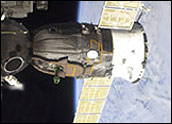
After two critical computers crashed aboard the international space station (ISS) Wednesday, U.S. and Russian flight controllers have partially restored functioning, but long-term prospects remain uncertain.
The crash occurred Wednesday while crew members were working to retract a solar array as part of their scheduled mission. One of the computers is located in the Zarya service module of the space station, while the other is in the Zvezda portion; together, they control orientation of the space station, along with supply of oxygen and water to the crew, Bill Jeffs, a NASA spokesperson, told TechNewsWorld.
“This is serious,” James Oberg, a retired rocket scientist who is now an author and consultant, told TechNewsWorld. “These computers run their life support, so if they can’t be restored, the space station could become uninhabitable.”
One-Third There
The European Space Agency provided the German-made computers, which were built and delivered in the 1990s. Each has three redundant lanes, of which only one has been restored so far on each computer, Jeffs explained.
“So far, they’ve only scratched the surface,” Oberg said.
Russian flight controllers believe the problem relates to power and not software, but they are still testing and troubleshooting. A false fire alarm resulted early Thursday when the computers were restarted.
The Right Alignment
The ISS is operated primarily by the Russian and U.S. space agencies, with contributions from those in Canada, Europe and Japan. Unfortunately, because of limits in communications with Russian ground controllers, much of the next diagnostic work on the failed computers will have to take place Thursday night.
U.S. crews communicate with ground control via satellite, but the Russian space agency lost its satellite communications years ago, and are able to communicate with ground staff only when the space station is in a favorable spot in its orbit around the earth, Oberg said.
U.S. staffers relay some basic information for the Russian crew via satellite, but there are a full 10 hours in each day when direct communication is impossible for Russian staff, Oberg said. So, for work like restoring the compromised computers — which will require high data-rate communications and uplinks — the crew will have to wait until direct communications are favorable during the night, he explained.
Meanwhile, “the Russians on board have been told to take naps today,” he said.
Work as Usual
The Space Shuttle Atlantis crew will continue to work on retracting the Port 6, or P6, solar array on Thursday, Jeffs said, while the station’scontrol moment gyroscopes handle attitude control, with backup from the shuttle’s propulsion system. The crew must also prepare for their next space walk, planned for Friday, on which they’ll work to repair a thermal blanket that pulled away from the orbital maneuvering system pod on the rear of the shuttle.
Throughout the week, crew members have been activating the Starboard 3 and 4 (S3/S4) truss segment that was attached to the station on Monday. The segment includes a pair of solar arrays that will be placed on the starboard side of the space station. They will complement the port-side pair of arrays that were installed last fall, and will add additional power-generation capabilities.
The crew is moving the older P6 array in order to make room for the new starboard arrays and allow them to rotate a full 360 degrees as they track the sun, Jeffs explained. Eventually, the P6 will be relocated to another part of the space station by a future shuttle crew.
A Long Haul
Meanwhile, the Atlantis is scheduled to leave the space station next Wednesday. Flight controllers will continue work on the compromised computers, but “even if everything goes smoothly, confidence will not be restored for at least a month,” Oberg said.
“Statistically, this is not random,” he noted. “There is some new environmental factor that must identified and isolated, and neither step is trivial.
“It will take a long time,” Oberg added. “In the meantime, we’ll watch closely and see what happens.”





















































